Beko GNEV122X, GNEV122S, GNEV122W, GNEV123T User manual [EN,PL,CS,SK,RU,FR,NL,DE,IT,ES,SL]

GNEV122X
GNEV122S
GNEV122W
GNEV123T
Refrigerator
Chłodziarka
Chladnička
Chladnička
Холодильник
Réfrigérateur
Koelkast
Kühlschrank Frigorifero Refrigerador
Hladilnik

Please read this manual first!
Dear Customer,
We hope that your product, which has been produced in modern plants and checked under the most meticulous quality control procedures, will provide you an effective service.
For this, we recommend you to carefully read the entire manual of your product before using it and keep it at hand for future references.
This manual
•Will help you use your appliance in a fast and safe way.
•Read the manual before installing and operating your product.
•Follow the instructions, especially those for safety.
•Keep the manual in an easily accessible place as you may need it later.
•Besides, read also the other documents provided with your product.
Please note that this manual may be valid for other models as well.
Symbols and their descriptions
This instruction manual contains the following symbols:
C Important information or useful usage tips.
AWarning against dangerous conditions for life and property.
BWarning against electric voltage.
This product is supplied with the selective sorting symbol for waste electrical Recycling and electronic equipment (WEEE).
This means that this product must be handled pursuant to European Directive 2002/96/EC in order to be recycled or dismantled to minimise its impact on the environment. For further information, please contact your local or regional authorities.
Electronic products not included in the selective sorting process are potentially dangerous for the environment and human health due to the presence of hazardous substances.
This product was manufactured using the latest technology in environmentally friendly conditions.
1 EN

CONTENTS
1 The refrigerator |
3 |
2 Important Safety Warnings |
4 |
Intended use........................................ |
4 |
For products with a water dispenser;.... |
6 |
Child safety.......................................... |
6 |
HCA Warning....................................... |
6 |
Things to be done for energy saving..... |
7 |
Reccomendations for freshfood |
|
compartment........................................ |
7 |
3 Installation |
8 |
Points to be considered when re- |
|
transporting your refrigerator................. |
8 |
Before operating your refrigerator.......... |
8 |
Electric connection............................... |
9 |
Disposing of the packaging................... |
9 |
Disposing of your old refrigerator.......... |
9 |
Placing and Installation......................... |
9 |
Floor balance adjustment.................... |
10 |
Adjusting the gap between the upper |
|
door................................................... |
12 |
4 Preparation |
13 |
5 Using your refrigerator |
14 |
Indicator Panel................................... |
14 |
Setting the fridge compartment |
|
temperature........................................ |
15 |
Setting the freezer compartment |
|
temperature........................................ |
15 |
Fast Freeze function........................... |
15 |
Quick cool function............................. |
15 |
Blue light............................................ |
16 |
Egg tray............................................. |
16 |
Sliding Body Shelves.......................... |
16 |
Crisper humidity control sliders........... |
17 |
Chiller compartment........................... |
17 |
Recommendations for preservation of |
|
frozen food......................................... |
18 |
Defrosting........................................... |
18 |
Replacing the Interior Light Bulb......... |
18 |
Ion: .................................................... |
18 |
6 Maintenance and cleaning21 |
|
Protection of plastic surfaces ............. |
21 |
7 Recommended solutions for |
|
the problems |
22 |
2 EN

1 |
The refrigerator |
|
|
|
|
|
|
1 |
2 |
|
|
|
|
|
|
|
3 |
|
*21 |
|
|
|
*4 |
|
|
|
|
|
5 |
|
*21 |
|
|
|
*6 |
|
|
|
|
7 |
|
|
22 |
|
|
|
8 |
|
|
|
|
9 |
|
|
|
|
|
|
|
|
*21 |
|
|
|
|
|
|
|
|
|
*10 |
|
20 |
|
|
|
|
|
|
|
|
|
*11 |
|
|
|
|
|
12 |
|
*19 |
|
|
|
|
|
|
|
|
|
13 |
|
|
|
|
|
14 |
|
15 |
18 |
*16 |
*17 |
15 |
1. |
Freezer compartment |
12.Bottle shelves |
2. |
Fridge compartment |
13.Crisper compartments |
3. |
Fridge compartment interior light |
14.Crisper cover |
4. |
Butter and cheese lid |
15.Adjustable front legs |
5. |
Fan |
16.Blue light |
6. |
Ioniser |
17.Chiller compartment |
7. |
Fridge compartment glass shelves |
18.Ventilation lid |
8. |
Egg tray |
19.Freezer compartment drawers |
9. |
Fridge compartment door racks |
20.Freezer Compartment glass shelves |
10.Wine cellar |
21.Icematic |
|
11.Bottle holder |
22.Freezer compartment interior light |
|
|
|
*OPTIONAL |
CFigures that take place in this instruction manual are schematic and may not correspond exactly with your product. If the subject parts are not included in the product you have purchased, then it is valid for other models.
3 EN

2 Important Safety Warnings
Please review the following information. Failure to observe this information may cause injuries or material damage. Otherwise, all warranty and reliability commitments will become invalid.
The usage life of the unit you purchased is 10 years. This is the period for keeping the spare parts required for the unit to operate as described.
Intended use
This product is intended to be used
–indoors and in closed areas such as homes;
–in closed working environments such as stores and offices;
–in closed accommodation areas such as farm houses, hotels, pensions.
• This product should not be used outdoors.
General safety
•When you want to dispose/scrap the product, we recommend you to consult the authorized service in
order to learn the required information and authorized bodies.
•Consult your authorized service for all your questions and problems related to the refrigerator. Do not intervene or let someone intervene to the refrigerator without notifying the authorised services.
•For products with a freezer compartment; Do not eat cone ice cream and ice cubes immediately after you take them out of the freezer compartment! (This may cause frostbite in your mouth.)
•For products with a freezer compartment; Do not put bottled and canned liquid beverages in the freezer compartment. Otherwise, these may burst.
•Do not touch frozen food by hand; they may stick to your hand.
•Unplug your refrigerator before cleaning or defrosting.
•Vapor and vaporized cleaning materials should never be used in cleaning and defrosting processes of your refrigerator. In such cases, the vapor may get in contact with the electrical parts and cause short circuit or electric shock.
•Never use the parts on your refrigerator such as the door as a means of support or step.
•Do not use electrical devices inside the refrigerator.
•Do not damage the parts, where the refrigerant is circulating, with drilling or cutting tools. The refrigerant that might blow out when the gas channels of the evaporator, pipe extensions or surface coatings are punctured causes skin irritations and eye injuries.
•Do not cover or block the ventilation holes on your refrigerator with any material.
•Electrical devices must be repaired by only authorised persons. Repairs performed by incompetent persons create a risk for the user.
•In case of any failure or during a maintenance or repair work,
disconnect your refrigerator’s mains supply by either turning off the relevant fuse or unplugging your appliance.
•Do not pull by the cable when pulling off the plug.
4 EN
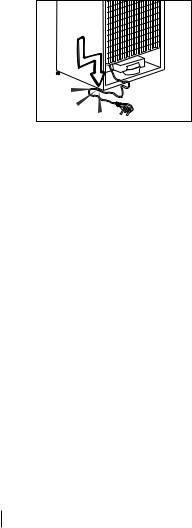
•Place the beverage with higher proofs tightly closed and vertically.
•Never store spray cans containing flammable and explosive substances in the refrigerator.
•Do not use mechanical devices or other means to accelerate the
defrosting process, other than those recommended by the manufacturer.
•This product is not intended to be used by persons with physical, sensory or mental disorders or unlearned or inexperienced people (including children) unless they are attended by a person who will be responsible for their safety or who will instruct them accordingly for use of the product
•Do not operate a damaged refrigerator. Consult with the service agent if you have any concerns.
•Electrical safety of your refrigerator shall be guaranteed only if the earth system in your house complies with standards.
•Exposing the product to rain, snow, sun and wind is dangerous with respect to electrical safety.
•Contact authorized service when there is a power cable damage to avoid danger.
•Never plug the refrigerator into the wall outlet during installation. Otherwise, risk of death or serious injury may arise.
•This refrigerator is intended for only storing food items. It must not be used for any other purpose.
•Label of technical specifications is located on the left wall inside the refrigerator.
•Never connect your refrigerator to electricity-saving systems; they may damage the refrigerator.
•If there is a blue light on the
refrigerator, do not look at the blue |
|
light with optical tools. |
5 |
|
•For manually controlled refrigerators, wait for at least 5 minutes to start the refrigerator after power failure.
•This operation manual should be handed in to the new owner of the product when it is given to others.
•Avoid causing damage on power cable when transporting the refrigerator. Bending cable may cause fire. Never place heavy objects on power cable. Do not touch the plug with wet hands when plugging the product.
•Do not plug the refrigerator if the wall outlet is loose.
•Water should not be sprayed directly on inner or outer parts of the product for safety purposes.
•Do not spray substances containing inflammable gases such as propane gas near the refrigerator to avoid fire and explosion risk.
•Never place containers filled with water on top of the refrigerator, otherwise this may cause electric shock or fire.
•Do not overload your refrigerator with excessive amounts of food. If overloaded, the food items may fall down and hurt you and damage refrigerator when you open the door. Never place objects on top of the refrigerator; otherwise, these objects
may fall down when you open or close the refrigerator's door.
•As they require a precise temperature, vaccines, heat-sensitive medicine and scientific materials and etc. should not
be kept in the refrigerator.
EN

•If not to be used for a long time, refrigerator should be unplugged. A possible problem in power cable may cause fire.
•The plug's tip should be regularly cleaned; otherwise, it may cause fire.
•The plug’s tip should be cleaned regularly with a dry cloth; otherwise, it may cause fire.
•Refrigerator may move if adjustable legs are not properly secured on the floor. Properly securing adjustable legs on the floor can prevent the refrigerator to move.
•When carrying the refrigerator, do not hold it from door handle. Otherwise, it may be snapped.
•When you have to place your product next to another refrigerator or freezer, the distance between devices should be at least 8cm. Otherwise, adjacent side walls may be humidified.
For products with a water dispenser;
Pressure of water mains should be minimum 1 bar. Pressure of water mains should be maximum 8 bars.
• Use only potable water.
Child safety
•If the door has a lock, the key should be kept away from reach of children.
•Children must be supervised to prevent them from tampering with the product.
HCA Warning
If your product's cooling system contains R600a:
This gas is flammable. Therefore, pay attention to not damaging the cooling system and piping during usage and transportation. In the event of damage, keep your product away from potential fire sources that can cause the product catch a fire and ventilate the room in which the unit is placed.
Ignore this warning if your product's cooling system contains R134a.
Type of gas used in the product is stated in the type plate which is on the left wall inside the refrigerator.
Never throw the product in fire for disposal.
6 EN
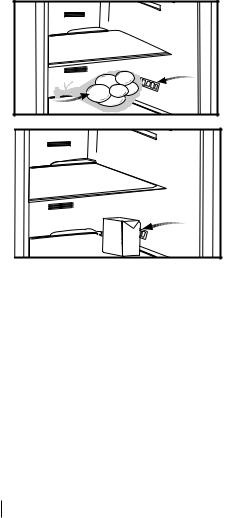
Things to be done for energy saving
•Do not leave the doors of your refrigerator open for a long time.
•Do not put hot food or drinks in your refrigerator.
•Do not overload your refrigerator so that the air circulation inside of it is not prevented.
•Do not install your refrigerator under direct sunlight or near heat emitting appliances such as ovens, dishwashers or radiators.
•Pay attention to keep your food in closed containers.
•For products with a freezer compartment; You can store maximum amount of food items in the freezer when you remove the shelf or drawer of the freezer. Energy consumption value stated for your refrigerator has been determined
by removing freezer shelf or drawer and under maximum load. There is no harm to use a shelf or drawer
according to the shapes and size of food to be frozen.
•Thawing frozen food in fridge compartment will both provide energy saving and preserve the food quality.
Reccomendations for freshfood compartment
* OPTIONAL
•Please do not let any foodstuff to come to contact with the temperature sensor in freshfood compartment.
In order to maintain freshfood compartment at ideal storage temperature, the sensor must not be blocked by fodstuffs.
•Do not place hot foodstuff in your appliance.
food |
temperature |
sensor |
MILK |
temperature |
juice |
|
etc. |
sensor |
|
7 EN
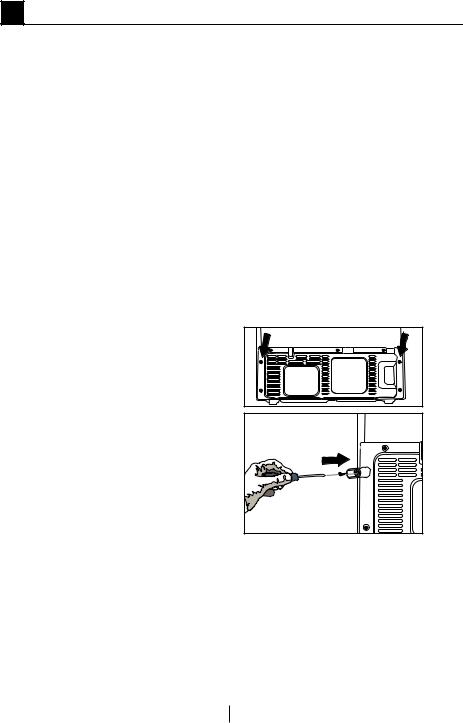
3 Installation
CPlease remember that the manufacturer shall not be held liable if the information given in the instruction manual is not observed.
Points to be considered when re-transporting your refrigerator
1.Your refrigerator must be emptied and cleaned prior to any transportation.
2.Shelves, accessories, crisper and etc. in your refrigerator must be fastened securely by adhesive tape against any jolt before repackaging.
3.Packaging must be tied with thick tapes and strong ropes and the rules of transportation printed on the package must be followed.
C Always remember...
Every recycled material is an indispensable source for the nature and for our national resources.
If you wish to contribute to recycling the packaging materials, you can get further information from the environmental bodies or local authorities.
Before operating your refrigerator
Before starting to use your refrigerator check the following:
1.Is the interior of the refrigerator dry and can the air circulate freely in the rear of it?
2.Clean the interior of the refrigerator as recommended in the “Maintenance and cleaning” section.
3.Insert the 2 plastic wedges onto the rear ventilation as illustrated in the following figure. Unscrew the existing ones and use the screws given in the same bag of wedges. Plastic wedges will provide the required distance between your refrigerator and the wall in order to allow the air circulation.
8 EN

4.Plug the refrigerator into the wall outlet. When the door is open the respective interior light will come on.
5.You will hear a noise as the compressor starts up. The liquid and gases sealed within the refrigeration system may also give rise to noise, even if the compressor is not running and this is quite normal.
6.Front edges of the refrigerator may feel warm. This is normal. These areas are designed to be warm to avoid condensation.
Electric connection
Connect your refrigerator to a grounded socket which is being protected by a fuse with the appropriate capacity.
Important:
B The connection must be in compliance with national regulations.
B The power cable plug must be easily accessible after installation.
B The specified voltage must be equal to your mains voltage.
B Extension cables and multiway plugs must not be used for connection.
B A damaged power cable must be replaced by a qualified electrician.
B The appliance must not be operated before it is repaired! There is danger of electric shock!
Disposing of the packaging
AThe packing materials may be dangerous for children. Keep the packing materials out of the reach of children or dispose them of by classifying them in accordance with the waste instructions. Do not
dispose them of along with the normal household waste.
The packing of your refrigerator is produced from recyclable materials.
Disposing of your old refrigerator
Dispose of your old machine without giving any harm to the environment.
A You may consult your authorized dealer or waste collection center of your municipality about the disposal of your refrigerator.
A Before disposing of your refrigerator, cut out the electric plug and, if there are any locks on the door, make them inoperable in order to protect children against any danger.
Placing and Installation
B Caution: Never plug the refrigerator into the wall outlet during installation. Otherwise, risk of death or serious injury may arise.
A If the entrance door of the room where the refrigerator will be installed is not wide enough for the refrigerator to pass through, than call the authorised service to have them remove the doors of your refrigerator and pass it sideways through the door.
1.Install your refrigerator to a place that allows ease of use.
2.Keep your refrigerator away from heat sources, humid places and direct sunlight.
3.There must be appropriate air ventilation around your refrigerator in order to achieve an efficient operation. If the refrigerator is to be placed in a recess in the wall, there must be at least 5 cm distance with the ceiling and at least 5 cm with the wall.
If the floor is covered with a carpet, your product must be elevated 2.5 cm from the floor.
4.Place your refrigerator on an even floor surface to prevent jolts.
5.Do not keep your refrigerator in ambient temperatures under 10°C.
9 EN
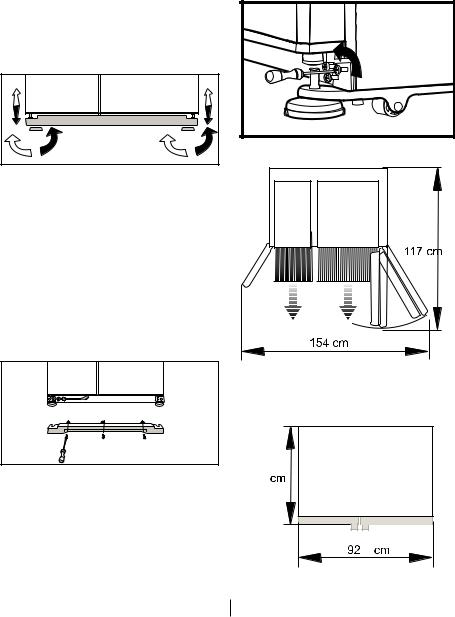
Floor balance adjustment
If your refrigerator is unbalanced;
You can balance your refrigerator by turning the front legs of it as illustrated in the figure. (See Figure A) The corner where the leg exists is lowered when you turn in the direction of black arrow and raised when you turn in the opposite direction. Taking help from someone to slightly lift the refrigerator will facilitate this process.
(A) |
Door height adjustment
In case there is a problem with the alignment of the doors with respect to each other, they may be re-aligned vertically in the order given below. Ensure that door shelves are empty when adjusting the door height.
1. Remove the lower ventilation cover by unscrewing its screws as shown in the figure below. (See Figure B)
2. Loosen the three screws of the hinges of the lower door, which you wish to escalate, with the help of a screwdriver as shown in the figure below. (Do not remove completely)
(See Figure C)
2 |
(C) |
 4
4
1 |
2 |
3 |
(B)  2
2
10 EN

• If the freezer compartment door is lower than the fridge compartment door, bring them to the same level by turning the turning the elevation screw on the freezer compartment side in the direction of arrow using a M6 Allen wrench as illustrated in Figure D.
• If the freezer compartment door is higher than the fridge compartment door, bring them to the same level by turning the elevation screw on the freezer compartment side in the reverse direction of arrow using a M6
Allen wrench as illustrated in Figure D.
After bringing the doors to the same level by elevating the front part with the aid of the elevation screws,ensure the doors of the refrigerator shall close properly. If the doors do not close properly, this might adversely affect the efficiency of the refrigerator.
(D)
11 EN
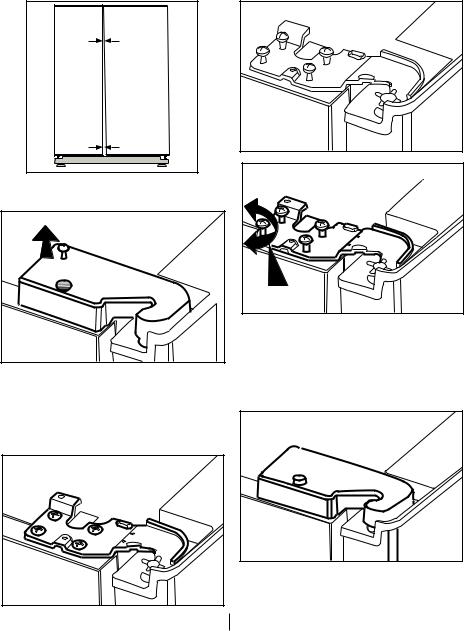
Adjusting the gap between the upper door
C You can adjust the gap between the fridge compartment doors as illustrated in the figures.
C Using a screwdriver, remove the screw of upper hinge cover of the door you want to adjust.
C Adjust the door appropriately as you desire by loosing the screws.
Door shelves should be empty when adjusting the door height.
Center Screw |
Because of being wires in the hinge cover of the freezer door, switch off the refrigerator power before removing hinge covers and this situation should be made to take care.
12 |
C Fix the door you have adjusted by tightening the screws without changing the position of the door.
C Replace the hinge cover and fix with the screw.
EN

4 Preparation
CYour refrigerator should be installed at least 30 cm away from heat sources such as hobs, ovens, central heater and stoves and at least 5 cm away from electrical ovens and should not be located under direct sunlight.
CThe ambient temperature of the room where you install your
refrigerator should at least be 10°C. Operating your refrigerator under cooler conditions than this is not recommended with regard to its efficiency.
CPlease make sure that the interior of your refrigerator is cleaned thoroughly.
CIf two refrigerators are to be installed side by side, there should be at least 2 cm distance between them.
CWhen you operate your refrigerator for the first time, please observe the following instructions during the initial six hours.
-The door should not be opened frequently.
-It must be operated empty without any food in it.
-Do not unplug your refrigerator. If a power failure occurs out of your control, please see the warnings in the “Recommended solutions for the problems” section.
COriginal packaging and foam materials should be kept for future transportations or moving.
13 EN
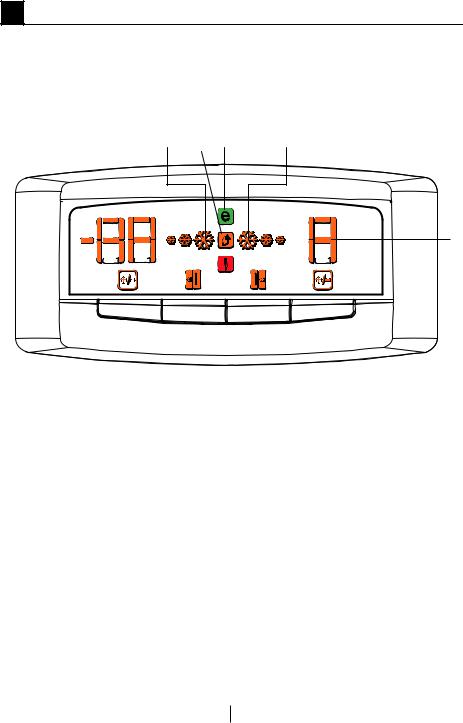
5 Using your refrigerator
Indicator Panel
Indicator panel aids in using your refrigerator with its audio and visual functions.
This panel allows you to start and use all functions of your refrigerator without opening its doors since the panel is located on the outer side of the freezer compartment door.
3 |
7 |
14 |
11 |
8
|
|
|
|
|
|
|
|
|
|
|
|
|
|
|
|
|
|
|
|
|
|
|
|
|
|
|
|
|
|
|
|
|
|
|
|
|
|
|
|
|
|
|
|
|
|
|
|
|
|
|
|
|
|
|
|
|
|
|
|
|
|
|
|
|
|
|
|
|
|
|
|
|
|
|
|
|
|
|
|
|
|
|
|
|
|
|
|
|
|
|
|
|
|
|
|
|
|
|
|
|
|
|
|
|
|
|
|
|
|
|
|
|
|
|
|
|
|
|
|
|
|
|
|
|
|
|
|
|
|
|
|
|
|
|
|
|
|
|
|
|
|
|
|
|
|
|
|
|
|
|
|
|
|
|
|
|
|
|
|
|
|
|
|
|
|
|
|
|
|
|
|
|
|
|
|
|
|
|
|
|
|
|
|
|
|
|
|
|
|
|
|
|
|
|
|
|
|
|
|
|
|
|
|
|
|
|
|
|
|
|
|
|
|
|
|
|
|
|
|
|
|
|
|
|
|
|
|
|
|
|
|
|
|
|
|
|
|
|
|
|
|
|
|
|
|
|
|
|
|
|
|
|
|
|
|
|
|
|
|
|
|
|
|
|
|
|
|
|
|
|
|
|
|
|
|
|
|
|
|
|
|
|
|
|
|
|
|
|
|
|
|
|
|
|
|
|
|
|
|
|
|
|
|
|
|
|
|
|
|
|
1 15 2 |
4 |
5 |
|
9 |
12 |
13 |
6 |
10 |
|
|
|||||||||||||||||||
1. |
Freezer Compartment Temperature |
7. |
High humidity indicator |
|||||||||||||||||||||||||||
8. |
Fridge temperature setting indicator |
|||||||||||||||||||||||||||||
|
Setting indicator |
|
|
|
|
|
|
|
|
|||||||||||||||||||||
2. |
Freezer compartment temperature |
9. |
Error Indicator |
|
|
|
|
|||||||||||||||||||||||
|
setting button |
|
|
|
|
|
|
|
|
|
10.Fridge compartment temperature |
|||||||||||||||||||
3. |
Fast Freeze indicator |
|
|
|
|
|
|
|
|
|
|
change indicator |
||||||||||||||||||
4. |
Fast Freeze Button |
|
|
|
|
|
|
|
|
|
11.Quick cool indicator |
|||||||||||||||||||
5. |
Freezer door open indicator |
|
|
|
|
12.Quick Cool Button |
||||||||||||||||||||||||
6. |
Fridge compartment temperature |
|
13.Fridge door open indicator |
|||||||||||||||||||||||||||
|
adjustment button |
|
|
|
|
|
|
|
|
|
14.Economy mode |
|||||||||||||||||||
15.Freezer compartment temperature change indicator
CFigures that take place in this instruction manual are schematic and may not correspond exactly with your product. If the subject parts are not included in the product you have purchased, then it is valid for other models.
14 EN

Setting the fridge compartment temperature
When you want to change your refrigerator’s temperature settings, you need to press the “Fridge compartment temperature adjustment button” to make the fridge compartment temperature adjustment. The fridge compartment temperature can be set to cooler degrees every time you press on the button (such as 8, 6, 4, 2, 8, …).
Setting the freezer compartment temperature
When you want to change your refrigerator’s temperature settings, you need to press the “Freezer compartment temperature adjustment button” to make the freezer compartment temperature adjustment. The freezer compartment temperature can be set to cooler degrees every time you press on the button (such as, -18, -20, -22, -24, -18, …).
Freezer Compartment Temperature Adjustment Indicator turns to -27°C. While fast freeze function is activated, this compartment reaches colder degrees than the adjusted values and all of the freezer compartment temperature indicators may light
up. Fast Freeze function lasts for maximum 24 hours. Your refrigerator will automatically exit the fast freeze mode once the fast freeze process is completed, fast freeze indicator lamp will go off and the refrigerator will turn back to the previously adjusted temperatures. Freezer compartment
temperature indicators will gradually go off until the adjusted temperature value is attained.
If you have unintentionally switched your refrigerator to fast freeze mode or if you want to cancel the process, just press the “Fast Freeze” button again to exit the fast freeze mode.
If you want to freeze large amounts of fresh food, press the fast freeze button 24 hours before putting the food into the freezer compartment.
Fast Freeze function
You can use this function of your refrigerator to rapidly freeze the food you put into the freezer compartment for the first time or to obtain ice more quickly. If you want to keep your food frozen for a long period, first apply the fast freeze function to them. Fast freeze is the healthiest way of keeping the food for a long time. Temperature of your refrigerator’s freezer compartment drops down to -27°C during fast freeze process. When you want to use the “Fast Freeze” function, press on the fast freeze button. Fast freeze indicator lights up when you press the button.
Quick cool function
This function can be used for food placed in the fridge compartment and desired to be cooled down rapidly. Press quick cool button to activate the function. During this process, the quick cool indicator will light up and fridge compartment temperature adjustment indicator will turn into 1°C. While
quick cool function is activated, this compartment reaches colder degrees than the adjusted values. Meanwhile, all of the temperature indicators of the fridge compartment may light up. Quick cool process will take about 2
hours and at the end of this period, the quick cool indicator lamp will go off, and the refrigerator will turn back to the previously adjusted temperatures.
15 EN

Blue light
Foodstuff stored in the crispers that are enlightened with a blue light continue their photosynthesis by means of the wavelength effect of blue light and thus, preserve their freshness and increase their vitamin content.
Egg tray
You can install the egg holder to the desired door or body shelf.
Never store the egg holder in the freezer compartment
Sliding Body Shelves
Sliding body shelves can be pulled by slightly lifting up from the front and moved back and forth. They come to
a stop point when pulled towards front to allow you reach the foods placed at the back of the shelf; when it is pulled after slightly lifted upwards at the second stop point, the body shelf will be released.
The shelf should be hold tightly from the bottom as well in order to prevent it from tipping over. The body shelf is placed on the rails at the sides of the refrigerator body by bringing it to one lower or one upper level.
The body shelf should be pushed backwards to seat it completely.
 1 2
1 2
 3
3
4
16 EN
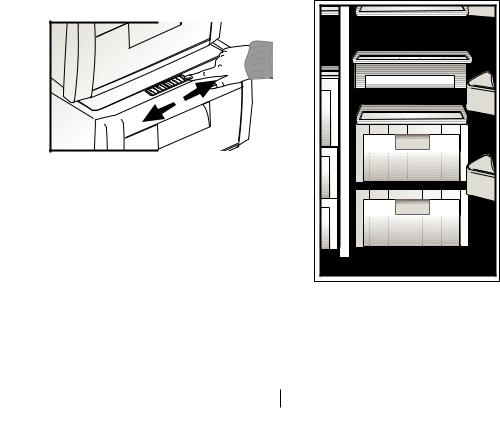
Crisper humidity control sliders
Crisper of your refrigerator is designed especially fresh to keep your vegetables freshly without loosing their humidity. Cold air circulates basically around the crisper and the amount of
the cold air passing through the crisper is controlled by the sliders on the front side of the crisper cover.
You can adjust the humidity control sliders to a suitable position according to the humidity and cooling condition of your food in the crisper.
If you want your food in the crisper to cool more, open the holes of the humidity control sliders and if you want them to cool less and keep their humidity for a longer time, close the holes.
Chiller compartment
If you wish to use the storage container under the shelf as the Chiller compartment, the storage container under the shelf should be placed as shown in the picture.
Chiller compartments enable the foods to be frozen become ready for freezing. You can also use these
compartments to store your food at a temperature a few degrees below the fridge compartment.
You can increase the inner volume of your refrigerator by removing any of the chiller compartments. To do this, pull the compartment towards yourself; the compartment will lean against the stopper and stop. This compartment will be released when you lift it about 1 cm and pull it towards yourself.
17 EN

Recommendations for preservation of frozen food
•Prepacked commercially frozen food should be stored in accordance with the frozen food manufacturer's instructions for a  ( 4 star) frozen food storage compartment.
( 4 star) frozen food storage compartment.
•To ensure that the high quality achieved by the frozen food manufacturer and the food retailer is maintained, the following should be remembered:
1.Put packets in the freezer as quickly as possible after purchase.
2.Ensure that contents are labelled and dated.
3.Do not exceed "Use By", "Best Before" dates on the packaging.
If there is a power failure do not open the freezer door. Even if the power failure lasts up to the time specified on Type Label (inside left of the refrigerator), frozen food will not be affected. In case the failure lasts
longer, the food must be checked and when necessary, must be consumed immediately or must be frozen after cooked.
Defrosting
The fridge and freezer compartments defrost automatically.
Replacing the Interior Light Bulb
Should the light fail to work, proceed as follows:
1. Switch off at the socket outlet and pull out the mains plug.
Remove all shelves and drawers for easy access.
2.Illumination covers in freezer and fridge sections are opened by pressing by hand; first release one side and then the other by pressing on the sides as shown in the figures.
3.First check that the bulb has not worked loose by ensuring that it
is screwed securely in the holder.
Reinsert the plug and switch on. If the bulb works, reinstall the light cover by inserting the rear lug and pushing up to locate the front two lugs.
4.If the light still fails to work, switch off at the socket outlet and pull out the mains plug. Replace the bulb with a new 15 watt (max) screw cap E14 (SES) bulb.
5.Carefully dispose of the burnt-out light bulb immediately.
Replacement light bulb can easily be obtained from a good local electrical or DIY store.
Ion:
Air is ionized by means of the ionizer system in the fridge compartment air duct. Thanks to this system, air-borne bacteria and particles that cause odour are removed.
18 EN
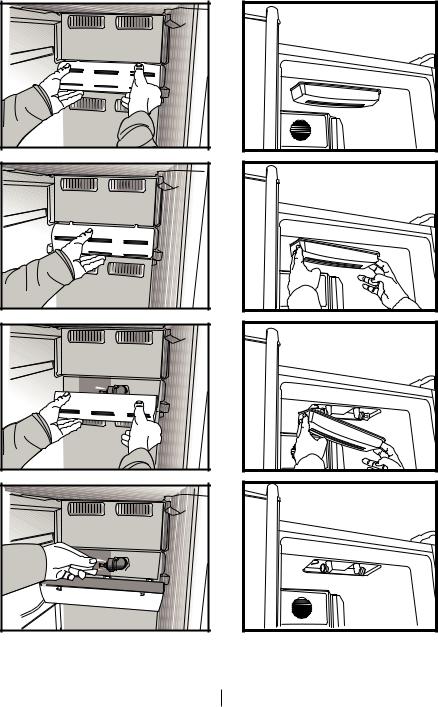
19 EN

Icematic |
|
|
|
|
|
|
|
|
|
* When the Icematic water supply |
|
|
|
|
reservoir (1) is removed from its place |
|
|
|
|
in order to fill it up, it must be replaced |
|
|
|
|
within two minutes after it is filled with |
|
|
|
|
water. The nozzle of the system will |
|
|
|
|
open and the Icematic cells will be |
|
|
|
|
filled with water automatically as soon |
|
|
|
|
as the cartridge is seated in its place. |
|
|
|
|
|
|
|
|
|
Your ice will be ready approximately in |
|
|
|
|
two 2 hours. |
|
|
|
|
|
|
|
|
|
• Do not remove the Icematic (2) from |
|
|
|
|
its seating to take ice. |
|
|
|
|
• Turn the knobs on it clockwise as |
|
|
|
|
illustrated in the figure. |
|
|
|
|
|
|
|
|
|
Ice cubes in the cells will fall down in to |
|
|
|
|
the ice bank (3) below. |
|
|
|
|
• You may take out the ice bank and |
|
|
|
|
serve the ice cubes. |
|
|
|
|
• If you wish, you may keep the ice |
|
|
1 |
|
cubes in the ice bank. |
|
|
|
|
|
|
|
|
|
The ice bank is just for |
|
|
|
|
accumulating ice cubes. Do not |
|
|
|
|
put water in it. Otherwise, it will |
|
|
|
|
|
|
|
|
|
break. |
|
|
|
|
About water supply reservoir |
|
|
|
|
Remove the water supply reservoir and |
|
|
|
|
|
|
|
|
|
fill it up with water. After filled up with |
|
|
|
|
water, the reservoir must be pushed |
|
|
|
|
forward into its seating until a “click” |
|
|
|
|
sound is heard. If there is any ice in |
|
|
|
|
the reservoir, wait until it melts. Water |
|
|
|
|
supply reservoir has a capacity of |
|
|
|
|
approximately 290 ml. |
|
|
|
|
20 EN

6 Maintenance and cleaning
A Never use gasoline, benzene or similar substances for cleaning purposes.
B We recommend that you unplug the appliance before cleaning.
B Never use any sharp abrasive instrument, soap, household cleaner, detergent and wax polish for cleaning.
CUse lukewarm water to clean the cabinet of your refrigerator and wipe it dry.
CUse a damp cloth wrung out in a solution of one teaspoon of bicarbonate of soda to one pint of
water to clean the interior and wipe it dry.
B Make sure that no water enters the lamp housing and other electrical items.
B If your refrigerator is not going to be used for a long period of time, unplug the power cable, remove all food, clean it and leave the door ajar.
CCheck door seals regularly to ensure they are clean and free from food particles.
A To remove door racks, remove all the contents and then simply push the door rack upwards from the base.
Protection of plastic surfaces
CDo not put the liquid oils or oil-cooked meals in your refrigerator in unsealed containers as they damage the plastic surfaces of your refrigerator. In case of spilling or smearing oil on the plastic surfaces, clean and rinse the relevant part of the surface at once with warm water.
21 EN

7 Recommended solutions for the problems
Please review this list before calling the service. It might save you time and money. This list includes frequent complaints that are not arising from defective workmanship or material usage. Some of the features described here may not exist in your product.
The refrigerator does not operate.
•Is the refrigerator properly plugged in? Insert the plug to the wall socket.
•Is the fuse of the socket which your refrigerator is connected to or the main fuse blown out? Check the fuse.
Condensation on the side wall of the fridge compartment (MULTIZONE, COOL CONTROL and FLEXI ZONE).
•Very cold ambient conditions. Frequent opening and closing of the door. Highly humid ambient conditions. Storage of food containing liquid in open containers.
Leaving the door ajar. Switching the thermostat to a colder degree.
•Decreasing the time the door left open or using it less frequently.
•Covering the food stored in open containers with a suitable material.
•Wipe the condensation using a dry cloth and check if it persists.
Compressor is not running
•Protective thermic of the compressor will blow out during sudden power failures or plug-out plug-ins as the refrigerant pressure in the cooling system of the refrigerator has not been balanced yet. Your refrigerator will start running approximately after 6 minutes. Please call the service if the refrigerator does not startup at the end of this period.
•The fridge is in defrost cycle. This is normal for a full-automatically defrosting refrigerator. Defrosting cycle occurs periodically.
•Your refrigerator is not plugged into the socket. Make sure that the plug is properly fit into the socket.
•Are the temperature adjustments correctly made?
•Power might be cut off.
22 EN
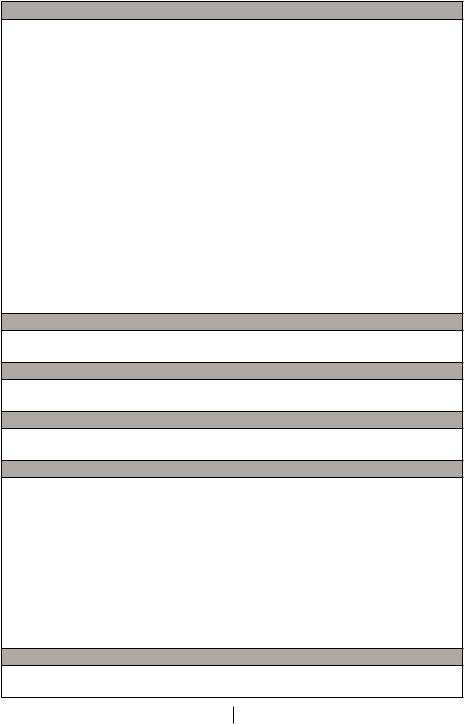
The fridge is running frequently or for a long time.
•Your new product may be wider than the previous one. This is quite normal. Large refrigerators operate for a longer period of time.
•The ambient room temperature may be high. This is quite normal.
•The refrigerator might have been plugged in recently or might have been loaded with food. Cooling down of the refrigerator completely may last for a couple of hours longer.
•Large amounts of hot food might have been put in the refrigerator recently. Hot food causes longer running of the refrigerator until they reach the safe storage temperature.
•Doors might have been opened frequently or left ajar for a long time. The warm air that has entered into the refrigerator causes the refrigerator to run for longer periods. Open the doors less frequently.
•Freezer or fridge compartment door might have been left ajar. Check if the doors are tightly closed.
•The refrigerator is adjusted to a very low temperature. Adjust the refrigerator temperature to a warmer degree and wait until the temperature is achieved.
•Door seal of the fridge or freezer may be soiled, worn out, broken or not properly seated. Clean or replace the seal. Damaged/broken seal causes the refrigerator to run for a longer period of time in order to maintain the current temperature.
Freezer temperature is very low while the fridge temperature is sufficient.
•The freezer temperature is adjusted to a very low temperature. Adjust the freezer temperature to a warmer degree and check.
Fridge temperature is very low while the freezer temperature is sufficient.
•The fridge temperature might have been adjusted to a very low temperature.
Adjust the fridge temperature to a warmer degree and check.
Food kept in the fridge compartment drawers are freezing.
•The fridge temperature might have been adjusted to a very low temperature.
Adjust the fridge temperature to a warmer degree and check.
Temperature in the fridge or freezer is very high.
•The fridge temperature might have been adjusted to a very high degree.
Fridge adjustment has an effect on the temperature of the freezer. Change the temperature of the fridge or freezer until the fridge or freezer temperature reaches to a sufficient level.
•Doors might have been opened frequently or left ajar for a long time; open them less frequently.
•Door might have been left ajar; close the door completely.
•Large amount of hot food might have been put in the refrigerator recently. Wait until the fridge or freezer reaches the desired temperature.
•The refrigerator might have been plugged in recently. Cooling down of the refrigerator completely takes time.
The operation noise increases when the refrigerator is running.
•The operating performance of the refrigerator may change due to the changes in the ambient temperature. It is normal and not a fault.
23 EN

Vibrations or noise.
•The floor is not even or it is weak. The refrigerator rocks when moved slowly.
Make sure that the floor is strong enough to carry the refrigerator, and level.
•The noise may be caused by the items put onto the refrigerator. Items on top of the refrigerator should be removed.
There are noises coming from the refrigerator like liquid spilling or spraying.
•Liquid and gas flows happen in accordance with the operating principles of your refrigerator. It is normal and not a fault.
There is a noise like wind blowing.
•Fans are used in order to cool the refrigerator. It is normal and not a fault.
Condensation on the inner walls of refrigerator.
•Hot and humid weather increases icing and condensation. It is normal and not a fault.
•Doors might have been left ajar; make sure that the doors are closed fully.
•Doors might have been opened frequently or left ajar for a long time; open them less frequently.
Humidity occurs on the outside of the refrigerator or between the doors.
•There might be humidity in the air; this is quite normal in humid weather. When the humidity is less, condensation will disappear.
Bad odour inside the refrigerator.
•Inside of the refrigerator must be cleaned. Clean the inside of the refrigerator with a sponge, lukewarm water or carbonated water.
•Some containers or package materials might cause the smell. Use a different container or different brand packaging material.
The door is not closing.
•Food packages may prevent the door's closing. Replace the packages that are obstructing the door.
•The refrigerator is not completely upright on the floor and rocking when slightly moved. Adjust the elevation screws.
•The floor is not level or strong. Make sure that the floor is level and capable to carry the refrigerator.
Crispers are stuck.
•The food might be touching the ceiling of the drawer. Rearrange food in the drawer.
24 EN

Prosimy najpierw przeczytać tę instrukcję obsługi!
Drodzy Klienci,
Mamy nadzieję, że nasz wyrób, wyprodukowany w nowoczesnym zakładzie i sprawdzony według najbardziej drobiazgowych procedur kontroli jakości, będzie Wam dobrze służył.
Dlatego zalecamy, aby uważnie przeczytać całą instrukcję obsługi tego wyrobu przed jego uruchomieniem i zachować ją do wglądu w przyszłości.
Instrukcja niniejsza
•Pomoże używać tego urządzenia sprawnie i bezpiecznie.
•Przeczytajcie tę instrukcję przed zainstalowaniem i uruchomieniem lodówki.
•Postępujcie zgodnie z tymi wskazówkami, zwłaszcza dotyczącymi bezpieczeństwa.
•Przechowujcie te instrukcję w łatwo dostępnym miejscu, bo może się przydać później.
•Prosimy przeczytać także inne dokumenty dostarczone wraz z lodówką.
Instrukcja ta może odnosić się także do innych modeli.
Symbole i ich znaczenie
Niniejsza instrukcja obsługi zawiera następujące symbole:
C Ważne informacje lub przydatne wskazówki użytkowania.
AOstrzeżenie przed zagrożeniem życia i mienia.
BOstrzeżenie przed porażeniem elektrycznym.
Utylizacja |
Wyrób ten nosi symbol selektywnego sortowania odpadów urządzeń elektrycznych i |
|
elektronicznych (WEEE). |
||
|
||
|
Znaczy to, że w celu zminimalizowania oddziaływania na środowisko naturalne wyrób |
|
|
ten należy poddać utylizacji lub rozebrać zgodnie z Dyrektywą Europejską 2002/96/WE. |
|
|
Bliższe informacje uzyskać można od władz lokalnych lub regionalnych. |
Ze względu na zawartość substancji szkodliwych wyroby elektroniczne nie poddane procesowi selektywnego sortowania mogą być niebezpieczne dla środowiska naturalnego i zdrowia ludzi.
1 PL

SPIS TREŚCI
1 Chłodziarka |
3 |
2 Ważne ostrzeżenia dot. |
|
bezpieczeństwa |
4 |
Zamierzone przeznaczenie.................... |
4 |
Ogólne zasady bezpieczeństwa............ |
4 |
Bezpieczeństwo dzieci.......................... |
6 |
Ostrzeżenie HCA.................................. |
6 |
Co robić, aby oszczędzać energię........ |
7 |
Zalecenia dot. komory na żywność |
|
świeżą.................................................. |
7 |
3 Instalacja |
8 |
W razie potrzeby ponownego transportu |
|
chłodziarki należy przestrzegać |
|
następujących wskazówek:.................. |
8 |
Przed uruchomieniem chłodziarki.......... |
8 |
Połączenia elektryczne.......................... |
9 |
Usuwanie opakowania.......................... |
9 |
Utylizacja starej chłodziarki.................... |
9 |
Ustawienie i instalacja........................... |
9 |
Wyrównanie nierówności podłogi........ |
10 |
Ustawianie szczeliny między górnymi |
|
drzwiczkami....................................... |
12 |
4 Przygotowanie |
13 |
5 Obsługa chłodziarki |
14 |
Panel wskaźników.............................. |
14 |
Nastawianie temperatury komory |
|
chłodzenia.......................................... |
15 |
Nastawianie temperatury komory |
|
zamrażarki.......................................... |
15 |
Funkcja szybkiego zamrażania............ |
15 |
Funkcja szybkiego chłodzenia............. |
16 |
Niebieskie światło............................... |
16 |
Tacka na jajka..................................... |
16 |
Półki wysuwane.................................. |
16 |
Suwaki nastawiania wilgotności w |
|
pojemniku na świeże warzywa............ |
17 |
Jonizowanie: ..................................... |
17 |
Zalecenia co do przechowywania |
|
mrożonek........................................... |
18 |
Odszranianie...................................... |
18 |
Wymiana żarówki oświetlenia |
|
wewnętrznego.................................... |
18 |
Komora schładzania........................... |
20 |
6 Konserwacja i czyszczenie21 |
|
Zabezpieczenia powierzchni |
|
plastykowych .................................... |
21 |
7 Zalecane rozwiązania |
|
problemów |
22 |
2 PL

1 Chłodziarka |
|
|
|
|
|
1 |
2 |
|
|
|
|
|
|
3 |
*21 |
|
|
|
*4 |
|
|
|
|
5 |
*21 |
|
|
|
*6 |
|
|
|
7 |
|
22 |
|
|
|
8 |
|
|
|
9 |
|
|
|
|
|
|
*21 |
|
|
|
|
|
|
|
|
*10 |
20 |
|
|
|
|
|
|
|
|
*11 |
|
|
|
|
12 |
*19 |
|
|
|
|
|
|
|
|
13 |
|
|
|
|
14 |
15 |
18 |
*16 |
*17 |
15 |
1. |
Komora zamrażalnika |
12. |
Uchwyt na butelki |
2. |
Komora chłodziarki |
13. |
Komora na świeże warzywa |
3. |
Lampka komory chłodzenia |
14. |
Pokrywa pojemnika na świeże warzywa |
4. |
Pokrywa pojemnika na masło i ser |
15. |
Nastawiane nóżki przednie |
5. |
Wentylator |
16 |
Niebieskie światło |
6. |
Jonizator |
17.Tacka na przekąski |
|
7. |
Szklane półki w komorze chłodniczej |
18. |
Pokrywa wentylacyjna |
8. |
Tacka na jajka |
19. |
Szuflady w komorze zamrażalnika |
9. |
Półki w drzwiczkach komory chłodniczej |
20. |
Półki szklane w komorze zamrażalnika |
10. Komora z winem |
21. |
Kostkarka Icematic |
|
11. |
Półki na butelki |
22. |
Lampka komory zamrażania |
|
|
* OPCJONALNE |
|
C Rysunki w niniejszej instrukcji to tylko schematy i nie muszą ściśle odpowiadać Waszemu modelowi chłodziarki. Jeśli pewnych części nie ma w nabytej chłodziarce, to znaczy, że odnoszą się do innych modeli.
3 PL

2 Ważne ostrzeżenia dot. bezpieczeństwa
Prosimy przeczytać następujące ostrzeżenia. Ich nieprzestrzeganie grozi obrażeniami lub uszkodzeniem mienia. W takim przypadku tracą ważność wszelkie gwarancje i zapewnienia niezawodności.
Czas użytkowania nabytego urządzenia wynosi 10 lat. Przez ten czas utrzymujemy części zamienne potrzebne do jego zgodnego z opisem funkcjonowania.
Zamierzone przeznaczenie
•Urządzenie można używać wyłącznie w gospodarstwie domowym oraz:
–na zapleczu kuchennych personelu w sklepach, biurach i w innych miejscach pracy;
–w kuchniach wiejskich i przez gości hotelowych, w motelach i innych tego rodzaju miejscach;
–w pensjonatach serwujących nocleg ze śniadaniem;
–cateringu i w innych tego rodzajach zastosowaniach niedetalicznych.
•Nie należy używać jej na dworze. Nie nadaje się do użytkowania na dworze, nawet w miejscach zadaszonych.
Ogólne zasady bezpieczeństwa
•Gdy zechcecie pozbyć się tego urządzenia/ złomować je, zalecamy skonsultowanie się z autoryzowanym serwisem, aby uzyskać potrzebne informacje i poznać kompetentne organa.
•Konsultujcie się z Waszym autoryzowanym serwisem w sprawach wszelkich pytań i problemów związanych z tą lodówką. Bez powiadomienia autoryzowanego serwisu nie wolno samemu ani innym osobom naprawiać chłodziarki.
•Nie jedzcie lodów ani lodu bezpośrednio po wyjęciu ich z zamrażalnika! (Może to spowodować odmrożenia w ustach).
•Nie wkładajcie do zamrażalnika napojów w puszkach ani w butelkach. Mogą wybuchnąć.
•Nie dotykajcie palcami mrożonej żywności, bo może do nich przylgnąć.
•Do czyszczenia i rozmrażania lodówki nie wolno stosować pary ani środków czyszczących w tej postaci. W takich przypadkach para może zetknąć się z częściami urządzeń elektrycznych i spowodować zwarcie albo porażenie elektryczne.
•Nie wolno używać żadnych części lodówki, takich jak drzwiczki, jako podpory ani stopnia.
•Wewnątrz lodówki nie wolno używać urządzeń elektrycznych.
•Nie wolno uszkadzać obwodu chłodzącego, w którym krąży środek chłodzący, narzędziami do wiercenia i cięcia. Środek chłodzący, który może wybuchnąć skutkiem przedziurawienia przewodów gazowych parownika, przedłużeń rur lub powłok powierzchni, może spowodować podrażnienia skóry lub obrażenia oczu.
•Nie przykrywajcie żadnym materiałem ani nie blokujcie otworów wentylacyjnych w lodówce.
•Urządzenia elektryczne naprawiać mogą tylko wykwalifikowani fachowcy. Naprawy wykonywane przez osoby niekompetentne mogą powodować zagrożenie dla użytkowników.
•W razie jakiejkolwiek awarii, a także w trakcie prac konserwacyjnych lub napraw, odłączcie lodówkę od zasilania z sieci albo wyłączając odnośny bezpiecznik, albo wyjmując wtyczkę z gniazdka.
•Wyjmując przewód zasilający z gniazdka należy ciągnąć za wtyczkę, nie za przewód.
•Napoje o wyższej zawartości alkoholu wkładajcie do lodówki w ściśle zamkniętych naczyniach i w pozycji pionowej.
4 PL

•W urządzeniu nie należy przechowywać substancji wybuchowych ani pojemników z łatwopalnymi gazami pędnymi.
•W celu przyśpieszenia procesu rozmrażania lodówki nie należy używać
żadnych urządzeń mechanicznych ani innych środków poza zalecanymi przez jej producenta.
•Urządzenie to nie jest przeznaczone do obsługi przez osoby (w tym dzieci) z ograniczoną sprawnością fizyczną, zmysłową lub umysłową, czy bez odpowiedniego doświadczenia i umiejętności, o ile nie zapewni się im nadzoru lub instrukcji jego użytkowania ze strony osoby odpowiedzialnej za ich bezpieczeństwo.
•Nie uruchamiajcie lodówki, jeśli jest uszkodzona. W razie wątpliwości należy się skonsultować z serwisem.
•Bezpieczeństwo elektryczne tej lodówki gwarantuje się tylko jeśli system uziemienia Waszej instalacji domowej spełnia wymogi norm.
•Wystawianie tego urządzenia na działanie deszczu, śniegu, słońca i wiatru zagraża jego bezpieczeństwu elektrycznemu.
•W razie uszkodzenia przewodu zasilającego itp. skontaktujcie się z autoryzowanym serwisem, aby nie narażać się na zagrożenie.
•W trakcie instalowania chłodziarki nigdy nie wolno włączać wtyczki w gniazdko w ścianie. Może to zagrażać śmiercią lub poważnym urazem.
•Chłodziarka ta służy wyłącznie do przechowywania żywności. Nie należy jej używać w żadnym innym celu.
•Etykietka z danymi technicznymi chłodziarki umieszczona jest po lewej stronie w jej wnętrzu.
•Nie przyłączaj tej chłodziarki do systemu oszczędzania energii, ponieważ może to ją uszkodzić.
•Jeśli chłodziarka wyposażona jest w niebieskie światło, nie patrz na nie poprzez przyrządy optyczne.
•Jeśli od ręcznie nastawianej chłodziarki odłączy się zasilanie, prosimy odczekać co najmniej 5 minut, zanim ponownie się je załączy.
•Jeżeli zmieni się właściciel tej chłodziarki, niniejszą instrukcję obsługi należy przekazać wraz z nią nowemu właścicielowi.
•Przy przesuwaniu chłodziarki uważaj, żeby nie uszkodzić przewodu zasilającego. Aby zapobiec pożarowi nie wolno skręcać tego przewodu. Nie ustawiać na przewodzie
żadnych ciężkich przedmiotów. Gdy wtyczka chłodziarki jest wsadzona do gniazdka nie wolno jej dotykać wilgotnymi dłońmi.
•Nie wsadzaj wtyczki chłodziarki do obluzowanego gniazdka.
•Ze względów bezpieczeństwa nie pryskaj wodą bezpośrednio na zewnętrzne ani na wewnętrzne części chłodziarki.
•Ze względu na zagrożenie pożarem i wybuchem nie rozpylaj łatwopalnych materiałów, takich jak gaz propan itp., w pobliży chłodziarki.
•Nie stawiaj na chłodziarce przedmiotów wypełnionych wodą, ponieważ grozi to porażeniem elektrycznym lub pożarem.
•Nie przeciążaj chłodziarki nadmierną ilością żywności. Nadmiar żywności może wypaść, gdy otwiera się drzwiczki,
narażając użytkownika na obrażenia ciała lub uszkodzenie chłodziarki. Nie wolno stawiać żadnych przedmiotów na chłodziarce, ponieważ mogą spaść przy otwieraniu lub zamykaniu drzwiczek.
5 PL
